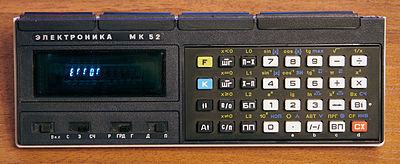It’s fun when hardware can do more than expected, or when malfunctions can be exploited. In the case of HP’s RPN calculators, discoveries of undocumented opcodes is called synthetic programming. In the case of Elektonika’s RPN calculators, it’s called eggogology.
You might guess the ‘egg’ is for Easter egg, but no, it’s because of latin and Cyrillic transliteration:

“Elektronika MK-52 with the message “ERROR” often read as “ЕГГОГ” pronounced “YGGOG”.”
It seems the Electronika units display ERROR but allow further calculation with overflowed numbers: there are almost 3 digits of exponent available, but only 2 digit exponents will be displayed.
In HP’s range too, there’s scope for experimenting with out of range numbers:
[people] who experimented with NNNs (nonnormalized numbers) on the HP-97 discovered that it was possible for the calculator to get into states where heating elements of the printhead were turned on but not turned off again in the required interval, thus permanently damaging the printhead
I remember on Casio scientifics being able to get non-decimal digits into the machine by pressing multiple keys. And the unpurchased features of the next model up were available by using the appropriate, but unmarked, keys (combinations, permutations, and coordinate conversion, as I recall.)
In the world of the celebrated HP-41, synthetic programming is the creation and use of unintended instructions in a user program. In fact it seems the same applies in the land of Elektronika:
There’s a detailed article at the HP Museum:
https://www.hpmuseum.org/prog/synth41.htm
and a nice PDF by Eric Smith about the reverse engineering angle. (The quote about NNN is from this.)